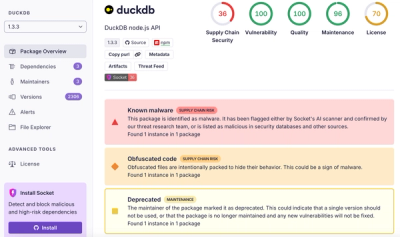
Product
Introducing Tier 1 Reachability: Precision CVE Triage for Enterprise Teams
Socket’s new Tier 1 Reachability filters out up to 80% of irrelevant CVEs, so security teams can focus on the vulnerabilities that matter.
CSSO (CSS Optimizer) is a CSS minifier. It performs three kinds of optimizations: structural optimizations, reducing CSS size by merging blocks with identical properties, removing overridden properties, etc.; cleaning (removing unused @media rules, cutting out the comments, etc.); and compressing (transforming values to shorter forms, merging identical selectors, etc.). It can be used as a command-line tool or as a library.
Minification
Minifies CSS by removing whitespace, comments, and making other optimizations to reduce file size.
const csso = require('csso');
const minifiedCss = csso.minify('.test { color: #ff0000; }').css;Structural Optimization
Optimizes CSS structure by merging blocks with identical properties and removing overridden properties.
const csso = require('csso');
const optimizedCss = csso.minify('.test { color: red; } .test { font-size: 16px; }', { restructure: true }).css;Source Map Generation
Generates a source map that can be used to debug the minified CSS by mapping it back to the original sources.
const csso = require('csso');
const result = csso.minify('.test { color: red; }', { sourceMap: true });
const minifiedCss = result.css;
const map = result.map.toString();clean-css is a fast and efficient CSS optimizer for Node.js and the Web. It provides similar minification capabilities as CSSO but also offers advanced optimizations like restructuring.
uglifycss is a CSS minifier that aims to be fast and simple. It doesn't have as many features as CSSO, focusing mainly on removing whitespace and comments to compress CSS files.
purifycss is a tool to remove unused CSS. Unlike CSSO, which focuses on optimizing existing CSS, purifycss analyzes your content and CSS files to remove unused selectors.
CSSO (CSS Optimizer) is a CSS minifier. It performs three sort of transformations: cleaning (removing redundants), compression (replacement for the shorter forms) and restructuring (merge of declarations, rules and so on). As a result an output CSS becomes much smaller in size.
npm install csso
import { minify } from 'csso';
// CommonJS is also supported
// const { minify } = require('csso');
const minifiedCss = minify('.test { color: #ff0000; }').css;
console.log(minifiedCss);
// .test{color:red}
Bundles are also available for use in a browser:
dist/csso.js – minified IIFE with csso as global<script src="node_modules/csso/dist/csso.js"></script>
<script>
csso.minify('.example { color: green }');
</script>
dist/csso.esm.js – minified ES module<script type="module">
import { minify } from 'node_modules/csso/dist/csso.esm.js'
minify('.example { color: green }');
</script>
One of CDN services like unpkg or jsDelivr can be used. By default (for short path) a ESM version is exposing. For IIFE version a full path to a bundle should be specified:
<!-- ESM -->
<script type="module">
import * as csstree from 'https://cdn.jsdelivr.net/npm/csso';
import * as csstree from 'https://unpkg.com/csso';
</script>
<!-- IIFE with an export to global -->
<script src="https://cdn.jsdelivr.net/npm/csso/dist/csso.js"></script>
<script src="https://unpkg.com/csso/dist/csso.js"></script>
CSSO is based on CSSTree to parse CSS into AST, AST traversal and to generate AST back to CSS. All CSSTree API is available behind syntax field extended with compress() method. You may minify CSS step by step:
import { syntax } from 'csso';
const ast = syntax.parse('.test { color: #ff0000; }');
const compressedAst = syntax.compress(ast).ast;
const minifiedCss = syntax.generate(compressedAst);
console.log(minifiedCss);
// .test{color:red}
Also syntax can be imported using csso/syntax entry point:
import { parse, compress, generate } from 'csso/syntax';
const ast = parse('.test { color: #ff0000; }');
const compressedAst = compress(ast).ast;
const minifiedCss = generate(compressedAst);
console.log(minifiedCss);
// .test{color:red}
Warning: CSSO doesn't guarantee API behind a
syntaxfield as well as AST format. Both might be changed with changes in CSSTree. If you rely heavily onsyntaxAPI, a better option might be to use CSSTree directly.
Gulp pluginGrunt pluginBroccoli pluginPostCSS pluginwebpack loaderwebpack pluginMinify source CSS passed as String.
const result = csso.minify('.test { color: #ff0000; }', {
restructure: false, // don't change CSS structure, i.e. don't merge declarations, rulesets etc
debug: true // show additional debug information:
// true or number from 1 to 3 (greater number - more details)
});
console.log(result.css);
// > .test{color:red}
Returns an object with properties:
String – resulting CSSObject – instance of SourceMapGenerator or nullOptions:
sourceMap
Type: Boolean
Default: false
Generate a source map when true.
filename
Type: String
Default: '<unknown>'
Filename of input CSS, uses for source map generation.
debug
Type: Boolean
Default: false
Output debug information to stderr.
beforeCompress
Type: function(ast, options) or Array<function(ast, options)> or null
Default: null
Called right after parse is run.
afterCompress
Type: function(compressResult, options) or Array<function(compressResult, options)> or null
Default: null
Called right after syntax.compress() is run.
Other options are the same as for syntax.compress() function.
The same as minify() but for list of declarations. Usually it's a style attribute value.
const result = csso.minifyBlock('color: rgba(255, 0, 0, 1); color: #ff0000');
console.log(result.css);
// > color:red
Does the main task – compress an AST. This is CSSO's extension in CSSTree syntax API.
NOTE:
syntax.compress()performs AST compression by transforming input AST by default (since AST cloning is expensive and needed in rare cases). Usecloneoption with truthy value in case you want to keep input AST untouched.
Returns an object with properties:
Object – resulting ASTOptions:
restructure
Type: Boolean
Default: true
Disable or enable a structure optimisations.
forceMediaMerge
Type: Boolean
Default: false
Enables merging of @media rules with the same media query by splitted by other rules. The optimisation is unsafe in general, but should work fine in most cases. Use it on your own risk.
clone
Type: Boolean
Default: false
Transform a copy of input AST if true. Useful in case of AST reuse.
comments
Type: String or Boolean
Default: true
Specify what comments to leave:
'exclamation' or true – leave all exclamation comments (i.e. /*! .. */)'first-exclamation' – remove every comment except first onefalse – remove all commentsusage
Type: Object or null
Default: null
Usage data for advanced optimisations (see Usage data for details)
logger
Type: Function or null
Default: null
Function to track every step of transformation.
To get a source map set true for sourceMap option. Additianaly filename option can be passed to specify source file. When sourceMap option is true, map field of result object will contain a SourceMapGenerator instance. This object can be mixed with another source map or translated to string.
const csso = require('csso');
const css = fs.readFileSync('path/to/my.css', 'utf8');
const result = csso.minify(css, {
filename: 'path/to/my.css', // will be added to source map as reference to source file
sourceMap: true // generate source map
});
console.log(result);
// { css: '...minified...', map: SourceMapGenerator {} }
console.log(result.map.toString());
// '{ .. source map content .. }'
Example of generating source map with respect of source map from input CSS:
import { SourceMapConsumer } from 'source-map';
import * as csso from 'csso';
const inputFile = 'path/to/my.css';
const input = fs.readFileSync(inputFile, 'utf8');
const inputMap = input.match(/\/\*# sourceMappingURL=(\S+)\s*\*\/\s*$/);
const output = csso.minify(input, {
filename: inputFile,
sourceMap: true
});
// apply input source map to output
if (inputMap) {
output.map.applySourceMap(
new SourceMapConsumer(inputMap[1]),
inputFile
)
}
// result CSS with source map
console.log(
output.css +
'/*# sourceMappingURL=data:application/json;base64,' +
Buffer.from(output.map.toString()).toString('base64') +
' */'
);
CSSO can use data about how CSS is used in a markup for better compression. File with this data (JSON) can be set using usage option. Usage data may contain following sections:
blacklist – a set of black lists (see Black list filtering)tags – white list of tagsids – white list of idsclasses – white list of classesscopes – groups of classes which never used with classes from other groups on the same elementAll sections are optional. Value of tags, ids and classes should be an array of a string, value of scopes should be an array of arrays of strings. Other values are ignoring.
tags, ids and classes are using on clean stage to filter selectors that contain something not in the lists. Selectors are filtering only by those kind of simple selector which white list is specified. For example, if only tags list is specified then type selectors are checking, and if all type selectors in selector present in list or selector has no any type selector it isn't filter.
idsandclassesare case sensitive,tags– is not.
Input CSS:
* { color: green; }
ul, ol, li { color: blue; }
UL.foo, span.bar { color: red; }
Usage data:
{
"tags": ["ul", "LI"]
}
Resulting CSS:
*{color:green}ul,li{color:blue}ul.foo{color:red}
Filtering performs for nested selectors too. :not() pseudos content is ignoring since the result of matching is unpredictable. Example for the same usage data as above:
:nth-child(2n of ul, ol) { color: red }
:nth-child(3n + 1 of img) { color: yellow }
:not(div, ol, ul) { color: green }
:has(:matches(ul, ol), ul, ol) { color: blue }
Turns into:
:nth-child(2n of ul){color:red}:not(div,ol,ul){color:green}:has(:matches(ul),ul){color:blue}
Black list filtering performs the same as white list filtering, but filters things that mentioned in the lists. blacklist can contain the lists tags, ids and classes.
Black list has a higher priority, so when something mentioned in the white list and in the black list then white list occurrence is ignoring. The :not() pseudos content ignoring as well.
* { color: green; }
ul, ol, li { color: blue; }
UL.foo, li.bar { color: red; }
Usage data:
{
"blacklist": {
"tags": ["ul"]
},
"tags": ["ul", "LI"]
}
Resulting CSS:
*{color:green}li{color:blue}li.bar{color:red}
Scopes is designed for CSS scope isolation solutions such as css-modules. Scopes are similar to namespaces and define lists of class names that exclusively used on some markup. This information allows the optimizer to move rules more agressive. Since it assumes selectors from different scopes don't match for the same element. This can improve rule merging.
Suppose we have a file:
.module1-foo { color: red; }
.module1-bar { font-size: 1.5em; background: yellow; }
.module2-baz { color: red; }
.module2-qux { font-size: 1.5em; background: yellow; width: 50px; }
It can be assumed that first two rules are never used with the second two on the same markup. But we can't say that for sure without a markup review. The optimizer doesn't know it either and will perform safe transformations only. The result will be the same as input but with no spaces and some semicolons:
.module1-foo{color:red}.module1-bar{font-size:1.5em;background:#ff0}.module2-baz{color:red}.module2-qux{font-size:1.5em;background:#ff0;width:50px}
With usage data CSSO can produce better output. If follow usage data is provided:
{
"scopes": [
["module1-foo", "module1-bar"],
["module2-baz", "module2-qux"]
]
}
The result will be (29 bytes extra saving):
.module1-foo,.module2-baz{color:red}.module1-bar,.module2-qux{font-size:1.5em;background:#ff0}.module2-qux{width:50px}
If class name isn't mentioned in the scopes it belongs to default scope. scopes data doesn't affect classes whitelist. If class name mentioned in scopes but missed in classes (both sections are specified) it will be filtered.
Note that class name can't be set for several scopes. Also a selector can't have class names from different scopes. In both cases an exception will thrown.
Currently the optimizer doesn't care about changing order safety for out-of-bounds selectors (i.e. selectors that match to elements without class name, e.g. .scope div or .scope ~ :last-child). It assumes that scoped CSS modules doesn't relay on it's order. It may be fix in future if to be an issue.
5.0.5 (August 10, 2022)
css-tree to ~2.2.0 (#458)FAQs
CSS minifier with structural optimisations
The npm package csso receives a total of 14,236,396 weekly downloads. As such, csso popularity was classified as popular.
We found that csso demonstrated a not healthy version release cadence and project activity because the last version was released a year ago. It has 3 open source maintainers collaborating on the project.
Did you know?

Socket for GitHub automatically highlights issues in each pull request and monitors the health of all your open source dependencies. Discover the contents of your packages and block harmful activity before you install or update your dependencies.

Product
Socket’s new Tier 1 Reachability filters out up to 80% of irrelevant CVEs, so security teams can focus on the vulnerabilities that matter.

Research
/Security News
Ongoing npm supply chain attack spreads to DuckDB: multiple packages compromised with the same wallet-drainer malware.

Security News
The MCP Steering Committee has launched the official MCP Registry in preview, a central hub for discovering and publishing MCP servers.